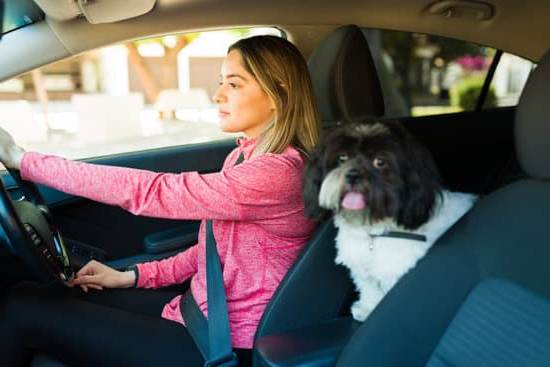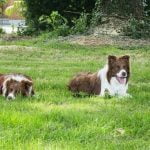How do you train a dog to smell? Training a dog to utilize its powerful sense of smell can have numerous practical applications, from search and rescue operations to detecting certain medical conditions. Understanding the importance of training a dog to smell is essential for owners looking to harness their pet’s olfactory abilities effectively.
Dogs possess an incredibly advanced sense of smell, with up to 300 million olfactory receptors in their noses compared to about six million in humans. This remarkable ability allows them to detect scents at incredibly low concentrations, making them invaluable partners in various fields such as law enforcement, agriculture, and healthcare.
By teaching your dog basic training techniques that associate scents with rewards, you can tap into their natural talent for smelling and turn it into a useful skill. Additionally, utilizing tools like scent detection kits and scent oils can aid in the training process by providing clear markers for your dog to identify. With the right guidance and consistent practice, you can help your canine companion develop strong scent detection abilities that can be applied in real-life scenarios.
The Science Behind a Dog’s Sense of Smell
Dogs have an incredibly powerful sense of smell, with some estimates suggesting that they can detect scents at concentrations nearly 100 million times lower than humans. But what makes a dog’s nose so exceptional? The key lies in the anatomy and physiology of their olfactory system.
Inside a dog’s nose are millions of scent receptors, far more than the mere thousands found in human noses. These receptors are located in a specialized area known as the olfactory epithelium, which is coated in a thin layer of mucus that helps capture scent molecules. Additionally, dogs have a large and complex olfactory bulb in their brains dedicated to processing scent information, allowing them to differentiate between different smells with incredible precision.
Furthermore, dogs possess a second olfactory system called the vomeronasal organ, or Jacobson’s organ. This structure is located near the nasal septum and is responsible for detecting pheromones, chemical signals that convey information between individuals of the same species.
This dual olfactory system gives dogs an extraordinary ability to not only detect scents but also to extract detailed information about the environment and other animals around them. Understanding these anatomical adaptations can provide insight into how effective training methods can tap into a dog’s natural scent abilities.
Basic Training Techniques
Understanding the Importance of Basic Training
Training a dog to smell is not only a fun activity but also serves a practical purpose. By teaching your furry friend how to recognize and differentiate scents, you are unlocking their natural abilities and enhancing their sensory perception. This can be especially useful in various real-life applications such as search and rescue missions, detecting drugs or explosives, and even identifying medical conditions.
The Relationship Between Scents and Rewards
One of the fundamental principles behind training a dog to smell is through positive reinforcement. By associating specific scents with rewards like treats or playtime, you are effectively teaching your dog to actively seek out those scents. This creates a strong motivation for them to engage in scent detection tasks and enhances their focus and determination.
How Do You Train a Dog to Smell Using Basic Techniques?
To begin training your dog’s sense of smell, start by introducing them to a particular scent that you want them to detect. Keep the initial sessions short and gradually increase the difficulty level as they progress. Encourage your dog to sniff around the designated area where the scent is hidden and reward them generously when they successfully locate it. Consistency, patience, and positive reinforcement are key elements in effectively training your dog to associate scents with rewards.
Choosing the Right Training Aids
Training a dog to smell involves more than just teaching them to recognize specific scents. It also requires the use of effective training aids that can help enhance your dog’s olfactory capabilities. By utilizing tools such as scent detection kits and scent oils, you can provide your furry friend with the necessary resources to sharpen their sense of smell and improve their detection skills.
One of the key training aids for teaching a dog to smell is a scent detection kit. These kits typically contain vials or containers with different scents that dogs can learn to detect and distinguish.
By using these kits during training sessions, you can help your dog become familiar with various scents and develop their ability to identify specific odors. Here are some popular scent detection kit options that you may consider incorporating into your dog’s training routine:
- Essential oil scent kits: These kits contain essential oils with distinct aromas such as lavender, peppermint, or eucalyptus. They can be used to introduce your dog to different scents and teach them how to associate each scent with a specific reward.
- Scent boxes or tubes: Scent boxes or tubes are containers that hold scented objects or materials for dogs to sniff out. You can place treats or toys inside these boxes or tubes along with scented items to encourage your dog to search for the hidden rewards.
- Customizable scent kits: Some companies offer customizable scent detection kits where you can select specific scents based on your training goals. This option allows you to tailor the training experience according to your dog’s preferences and abilities.
In addition to scent detection kits, another useful training aid for teaching a dog how to smell is scent oils. Scent oils are concentrated liquid fragrances that can be used to create scent trails or targets for your dog to follow.
By applying scent oils strategically in different environments, you can challenge your dog’s olfactory senses and test their ability to track down specific odors. Some common ways to incorporate scent oils into your dog’s training regimen include:
- Creating a scent trail: Dabbing small amounts of scent oil along a designated path or area can help your dog practice following a particular odor from start to finish.
- Setting up stationery targets: Placing drops of scent oil on objects like cones, poles, or flags can prompt your dog to locate and indicate the source of the odor without having to physically follow a trail.
- Introducing distractions: Mixing different scents using multiple scent oils can challenge your dog’s discrimination skills and teach them how to focus on detecting specific odors amidst other distracting smells.
By incorporating these tools into your training routine, you can provide your canine companion with valuable resources that will aid in honing their sense of smell and enhancing their overall olfactory abilities. Remember, consistency, patience, and positive reinforcement are key components when it comes to teaching a dog how important it is”.
Advanced Training Methods
Training a dog to smell efficiently and effectively involves implementing advanced techniques that push their olfactory abilities to the limit. Once your dog has successfully mastered basic scent detection tasks, it’s time to introduce more challenging exercises that will further hone their skills. But how do you train a dog to smell with increased difficulty?
One method is to start by expanding the range of scents that your dog is trained to detect. Introduce new odors gradually, ensuring that your furry companion can differentiate between them and alert you consistently. This process helps enhance your dog’s scent discrimination capabilities and prepares them for more complex scent detection scenarios.
Additionally, you can increase the complexity of search environments by adding distractions or obstacles. By creating scenarios where your dog must navigate through cluttered areas or crowded spaces to find the target scent, you are not only testing their olfactory prowess but also enhancing their problem-solving skills. These challenges simulate real-life situations where dogs are deployed for search and rescue missions, making them invaluable assets in critical operations.
As your dog progresses through these advanced training methods, make sure to provide ample positive reinforcement and rewards for successful detections. Building confidence in your dog’s ability to overcome difficult scent detection tasks is key to maintaining their motivation and commitment to the training process. With patience, consistency, and these advanced techniques, you can elevate your dog’s scent detection skills to impressive levels that are beneficial in various practical applications.
| Training Method | Description |
|---|---|
| Expand Range of Scents | Introduce new odors gradually to improve discrimination abilities |
| Increase Search Complexity | Add distractions or obstacles in search environments for enhanced problem-solving skills |
| Positive Reinforcement | Reward successful detections to boost motivation and confidence |
Real-Life Applications
Training a dog to smell goes beyond just a fun activity or a way to keep your pet entertained. In fact, it can have important real-life applications, particularly in search and rescue operations. Dogs with well-developed scent detection skills can be valuable assets in finding missing persons or locating survivors in disaster areas.
In search and rescue missions, trained dogs can use their keen sense of smell to detect scents that humans may not even be aware of. This includes tracking the scent of a missing person over long distances or identifying individuals trapped under debris after a natural disaster. By training dogs to associate specific scents with rewards, handlers can effectively direct their canine partners to locate the source of the scent, making them indispensable in critical situations.
To prepare a dog for search and rescue work, specialized training programs are often implemented that focus on enhancing the animal’s ability to detect various scents under challenging conditions. These programs involve gradually increasing the difficulty of scent detection tasks, introducing distractions, and simulating real-life scenarios where quick and accurate detection is crucial. Through consistent practice and reinforcement, dogs can become proficient in search and rescue operations, showcasing their incredible olfactory abilities in action.
Troubleshooting Common Issues
Training a dog to smell is a process that requires patience, consistency, and problem-solving skills. One common issue that many dog trainers face when teaching scent detection is distractions. Dogs are easily distracted by external stimuli such as other scents, noises, or even unfamiliar environments. To address this challenge, it’s important to start training in a controlled environment with minimal distractions and gradually increase the difficulty as your dog progresses.
Here are some tips for troubleshooting distractions during scent detection training:
- Start with short training sessions in a quiet room where your dog can focus solely on the scent.
- Gradually introduce more distractions such as background noise or other scents to help your dog learn to stay focused on the target smell.
- Reward your dog generously whenever they successfully identify the correct scent despite distractions to reinforce the desired behavior.
Another common issue that may arise during scent detection training is false alerts. A false alert occurs when your dog signals the presence of a target odor incorrectly, either due to confusion or misinterpretation. This can be frustrating for both you and your canine partner, but there are ways to address and prevent false alerts.
- Ensure that you have thoroughly established the target odor and reward association before advancing to more complex scent detection tasks.
- Avoid inadvertently cueing your dog’s response through unintentional body language or vocal cues that may lead to false alerts.
- If your dog consistently gives false alerts, consider going back to basics and reinforcing the foundation of their training before progressing further.
By addressing distractions and false alerts proactively during scent detection training, you can help your dog develop reliable and accurate olfactory skills. With patience, consistency, and problem-solving strategies, you can overcome these challenges and work towards maximizing your canine companion’s scent detection abilities for various real-life applications.
Maintaining and Reinforcing Training
Consistent Practice and Refresher Sessions
One of the most important aspects of maintaining your dog’s scent detection skills is consistent practice. Just like any skill, regular training sessions will help keep your dog sharp and focused on detecting scents. Set aside time each day to work on scent detection tasks with your dog to reinforce their training. Additionally, consider adding refresher sessions periodically to ensure that your dog does not lose the learned behaviors over time.
Introducing Variety in Training
To prevent your dog from becoming bored or complacent with their scent detection training, it is essential to introduce variety in the tasks they perform. Mix up the scents used in training, vary the locations where you conduct exercises, and incorporate different challenges to keep your dog engaged and stimulated. By introducing new elements into their training, you can help them stay motivated and excited about using their sense of smell.
Rewarding Successes and Maintaining Positive Reinforcement
Positive reinforcement is key to maintaining and reinforcing your dog’s scent detection skills over time. When your dog successfully identifies a scent or completes a task correctly, be sure to reward them with praise, treats, or playtime. This positive feedback will reinforce their behavior and encourage them to continue using their sense of smell effectively. Consistent rewards for successful detections will strengthen the bond between you and your dog while also keeping their skills sharp.
Conclusion
Training a dog to smell is not just about unlocking their natural abilities but also about tapping into their potential to assist humans in various tasks. By understanding the importance of training a dog’s sense of smell, we can appreciate the incredible science behind their powerful noses. Dogs have up to 300 million olfactory receptors in their noses, compared to about 6 million in humans, making them invaluable partners in scent detection tasks.
Basic training techniques involve teaching your dog to associate scents with rewards, laying the foundation for more advanced training methods. Utilizing tools like scent detection kits and oils can help in refining your dog’s ability to differentiate between different smells. Gradually increasing the difficulty of scent detection tasks through advanced training methods can challenge your dog and enhance their skills further.
Real-life applications of training a dog to smell are vast, particularly in search and rescue operations where their keen sense of smell can save lives. However, common issues such as distractions and false alerts need to be addressed through troubleshooting techniques.
Maintaining and reinforcing your dog’s scent detection skills over time is key to ensuring they remain sharp and reliable partners. In conclusion, by investing time and effort into training a dog to smell accurately, we unlock a world of possibilities where these furry companions can make a significant impact on our lives.
Frequently Asked Questions
What Scents to Use for Dog Scent Training?
When it comes to scent training for dogs, it’s important to use scents that are safe and familiar to them. Common scents include essential oils like lavender or pine, as well as natural scents like vanilla or cinnamon. These scents should be used consistently to help your dog associate them with certain behaviors or commands.
How Do I Teach My Dog to Track His Scent?
Teaching your dog to track his own scent can be a fun and rewarding experience for both you and your furry friend. To start, introduce a scent article (such as a rag or towel) with your dog’s scent on it.
Encourage your dog to sniff the article and then hide it somewhere for him to find using his tracking skills. Repeat this process regularly to reinforce the tracking behavior.
When Should I Start Scent Training My Dog?
Scent training can begin at any age, but ideally, it is best to start when your dog is still a puppy. Starting scent training early helps build a strong foundation for more advanced tasks later on.
However, if you have an older dog that hasn’t had scent training before, it’s never too late to start – just be patient and consistent in your training efforts.

Welcome to the blog! I am a professional dog trainer and have been working with dogs for many years. In this blog, I will be discussing various topics related to dog training, including tips, tricks, and advice. I hope you find this information helpful and informative. Thanks for reading!





